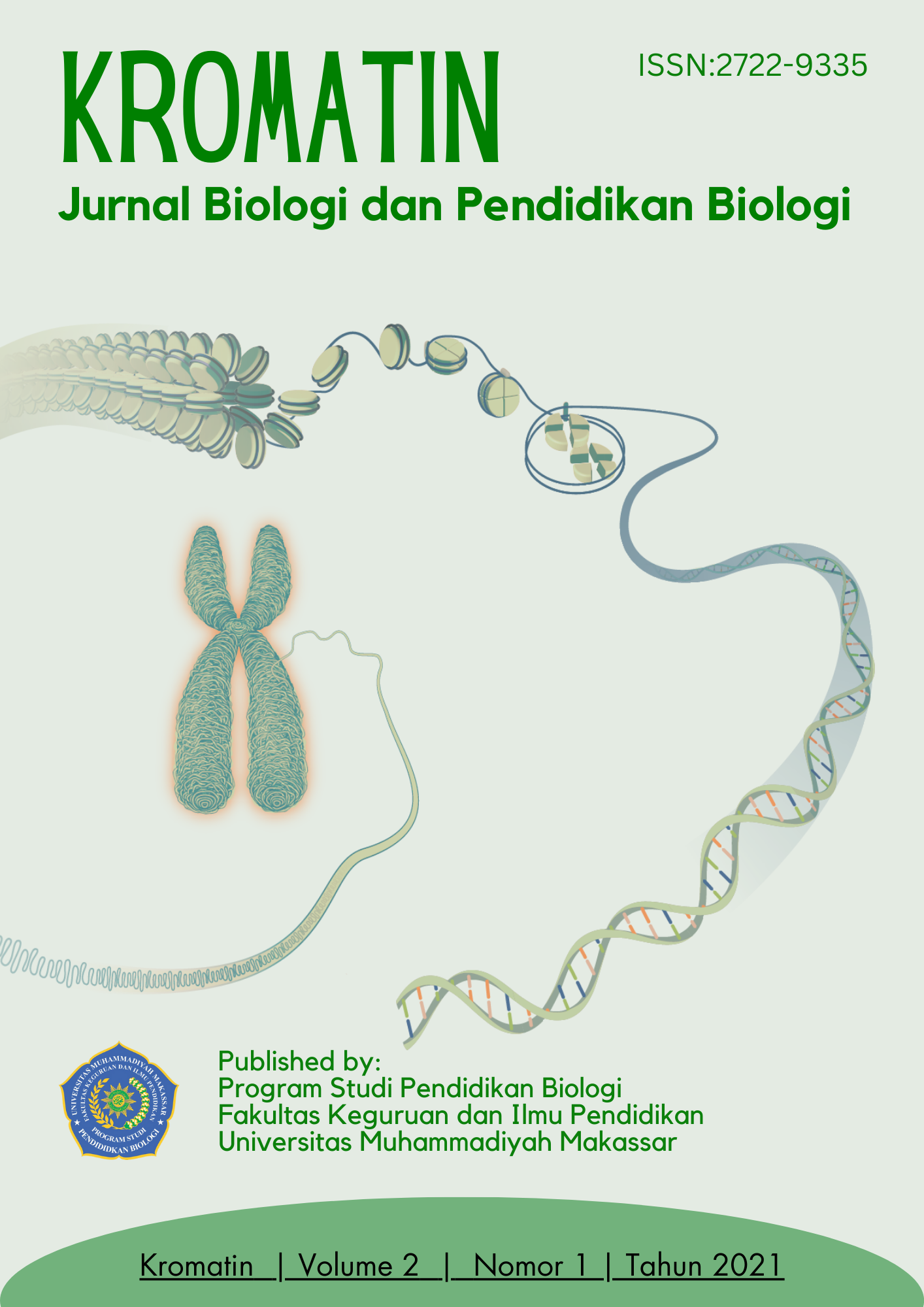Pengaruh Model Pembelajaran Hypnolearning terhadap Hasil Belajar Biologi Siswa Kelas XI IPA
Abstract
Hypnolearning learning model is a learning model that provides reinforcement in the form of suggestions in the form of verbal reinforcement such as changing students' subjective perceptions by saving attention in the form of greetings even outside of class hours, praise for work or giving motivations as well as non-verbal reinforcement such as activating subconscious mind in an enthusiastic way in giving material. This thesis discusses the application of the hypnolearning learning model to the learning outcomes of class XI science students at SMA Negeri 1 Sungguminasa Kab. Gowa, where class XI IPA6 became the experimental class and class XI IPA5 became the control class with a total of 68 people. With the formulation of the problem How are the learning outcomes of class XI science students at SMA Negeri 1 Sungguminasa Kab. Gowa on Biology subjects that are taught using the hypnolearning learning model, is there a significant effect between the learning outcomes of students who are taught with the hypnolearning learning model and those taught without the hypnolearning learning model for class XI IPA students of SMA Negeri 1 Sungguminasa Kab. Gowa. The research instruments used were tests, questionnaires, and observation sheets. Data processing was carried out by descriptive statistical analysis and inferential analysis. The variables studied in this study were the hypno learning model (free) and learning outcomes (bound). The results of data analysis showed that there was a significant influence between student learning outcomes using the hypnolearning learning model. From the comparison of the final learning outcomes of the experimental group there was an increase in the average score of 9.63 to an average score of 10.67. While in the control group the average score obtained was stable, namely 7.54. The results of this study can be concluded that the experimental group experienced a significant increase by looking at tcount ttable (2.18 > 1.67). This means that there is an increase in student learning outcomes using the hypnolearning learning model. The results of the analysis show that H0 is rejected. So this means that the hypnolearning learning model has a positive effect on Biology subjects for class XI science students at SMA Negeri 1 Sungguminasa Kab. Gowa. Keywords: Hypnolearning, learning aoutcomes, biologyReferences
Anonim. 2008. Powerfull Teaching. . Jakarta: International Transform.
Arikunto, S. 2002. Prosedur penelitian (Suatu Pendekatan Praktek). Jakarta: Rineka Cipta.
Aswar, S. 2007 Sikap Manusia. Yogyakarta: Pustaka Belajar.
Atkinson, R. 2005. Pengantar Psikologi. Jilid 2. Jakarta: Erlangga
Djamarah, S, B. 2002. Psikologi Belajar. Jakarta : PT. Rineka Cipta.
Fachri, H, A. 2008. The Real Art of Hypnosis. Jakarta: Gagas Media.
Fitriani. 2007. Meningkatkan Hasil Belajar Kimia Siswa Kelas X3 SMA Negeri 3 Makassar Melalui Model Pembelajaran konstruktivistik. Skripsi FMIPA UNM: Makassar.
Haling, A. 2006. Belajar dan Pembelajaran. Makassar: FMIPA UNM.
Bruce, G. 2007. Self Hypnosis. Yogyakarta: B First (Bentang Pustaka).. 2007
Gunawan, A, W. 2007. Genius Learning Strategy. Jakarta: PT. Ikrar Mandiriabadi.
Hasan, M. I. 2003. Pokok-Pokok Materi Statistik 2; Statistik Inferensial. Jakarta: PT. Bumi Aksara:
Indra. Hypnoteaching, efektifkah?.http://reducator1.multiply.com/journal/item/18/ hypnoteaching_efektifkah// (22 desember 2009)
Margono. 1997. Metodologi Peneltian Pendidikan. Jakarta: Rineka Cipta.
Mulyasa, E. 2008. Menjadi Guru Profesional. Bandung: Cet. VII, Rosdakarya:
Hamalaik, O. 2008. Proses Belajar Mengajar. Jakarta: Bumi Aksara.
Oktastika. Hypnoteaching 2. http://oktastika.blog.com/2008/09/02/hypnoteaching-2/ (22 Mei 2018)
Sulaiman, S, dkk. 2004. Profesi Keguruan. Fakultas Ilmu Pendidikan-UNM: Makasssar.
Sanjaya, W. 2006. Strategi Pembelajaran. Jakarta: Kencana Prenada Media Group.
Siska, S. 2009. Hypnolearning. http://anandasiska.com/2009/01/menghadapi-ujian-nasional.htm//. (22 Oktober 2009)
Slameto. 2003. Belajar dan Faktor-Faktor yang Mempengaruhinya. Jakarta: Rineka Cipta.
Sugiyono. 2006. Metode Penelitian Administrasi. Jakarta. CV. Alfabeta.
Sugiyono. 2008. Metode Penelitian Pendidikan. Bandung: CV. Alfabeta.
Sudjana, N. 2004. Dasar-dasar Proses Belajar Mengajar. Bandung: Sinar Baru Algensindo.
Tilaar, H. A. R. 2006. Standarisasi Pendidikan Nasional. Jakarta: PT. Rineka Cipta.
Tiro, M. A. 2000. Dasar-dasar Statistik. State University of Makassar Press: Makassar.
Triwidia, J., N. 2010. Hypno Teaching „Bukan Sekedar Mengajar“. Jakarta: D-Brain.
Usman, H. 2008. Pengantar Statistik. Jakarta: PT. Bumi Kasara.
Walgito, B. 2004. Pengantar Psikologi Umum. Jakarta: ANDI.
Downloads
Published
Issue
Section
License
Authors who publish with this journal agree to the following terms:
1. Authors retain copyright and grant the journal right of first publication with the work simultaneously licensed under a Creative Commons Attribution 4.0 Internasional License that allows others to share the work with an acknowledgement of the work's authorship and initial publication in this journal.
2. Authors are able to enter into separate, additional contractual arrangements for the non-exclusive distribution of the journal's published version of the work (e.g., post it to an institutional repository or publish it in a book), with an acknowledgement of its initial publication in this journal.
3. Authors are permitted and encouraged to post their work online (e.g., in institutional repositories or on their website) prior to and during the submission process, as it can lead to productive exchanges, as well as earlier and greater citation of published work.
Licence:
Authors are free to:
1. Share: Copy and redistribute the material in any medium or format
2. Adapt: Remix, transform, and build upon the material for any purpose, even commercially.
The licensor cannot revoke these freedoms as long as the authors follow the license terms, which include the following:
1. Attribution: Authors must give appropriate credit, provide a link to the license, and indicate if changes were made. Authors may do so in any reasonable manner, but not in any way that suggests the licensor endorses the authors or authors’ use.
2. No additional restrictions: Authors may not apply legal terms or technological measures that legally restrict others from doing anything the license permits.
This work is licensed under a licensed under a Creative Commons Attribution 4.0 Internasional License/ CC BY 4.0.


